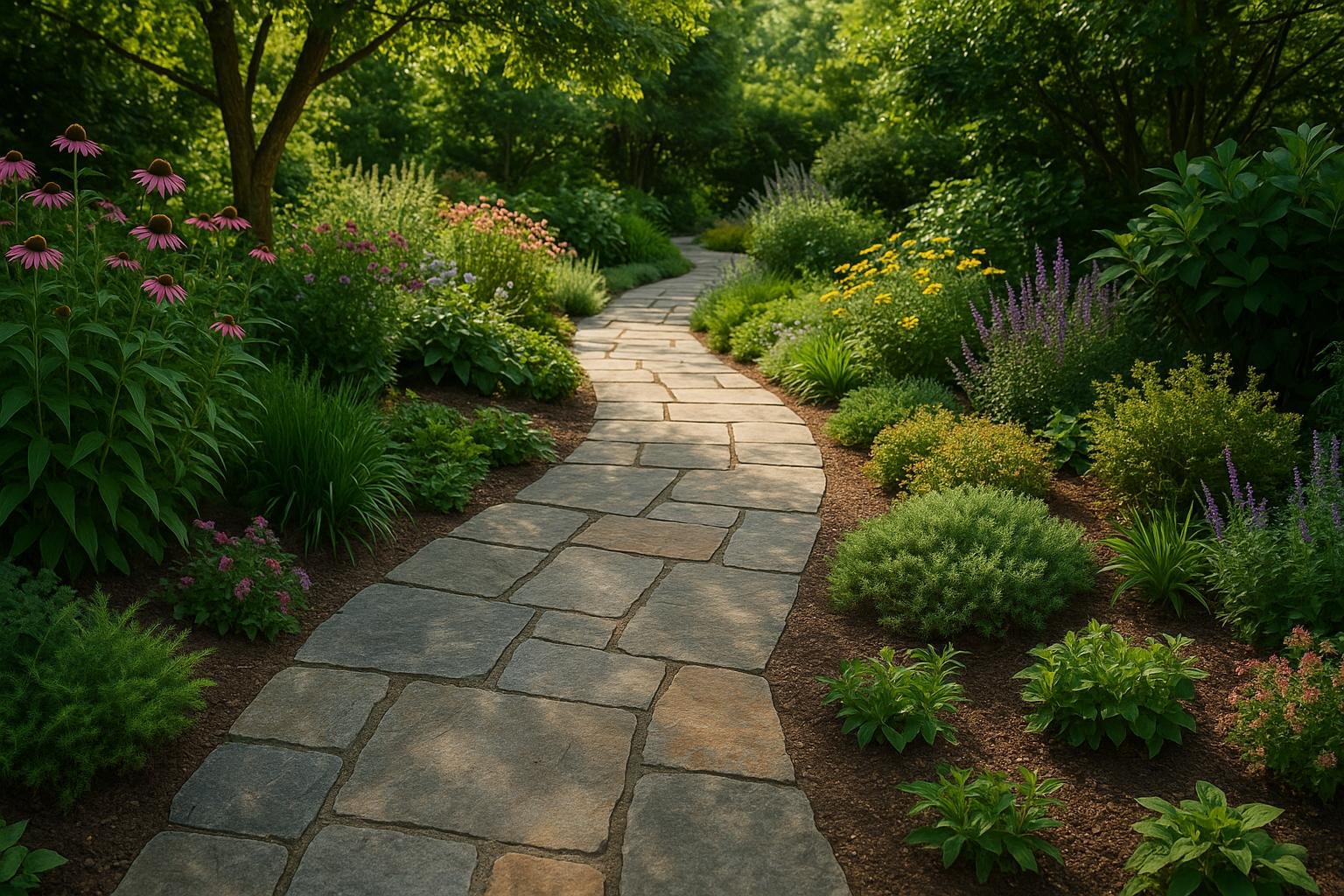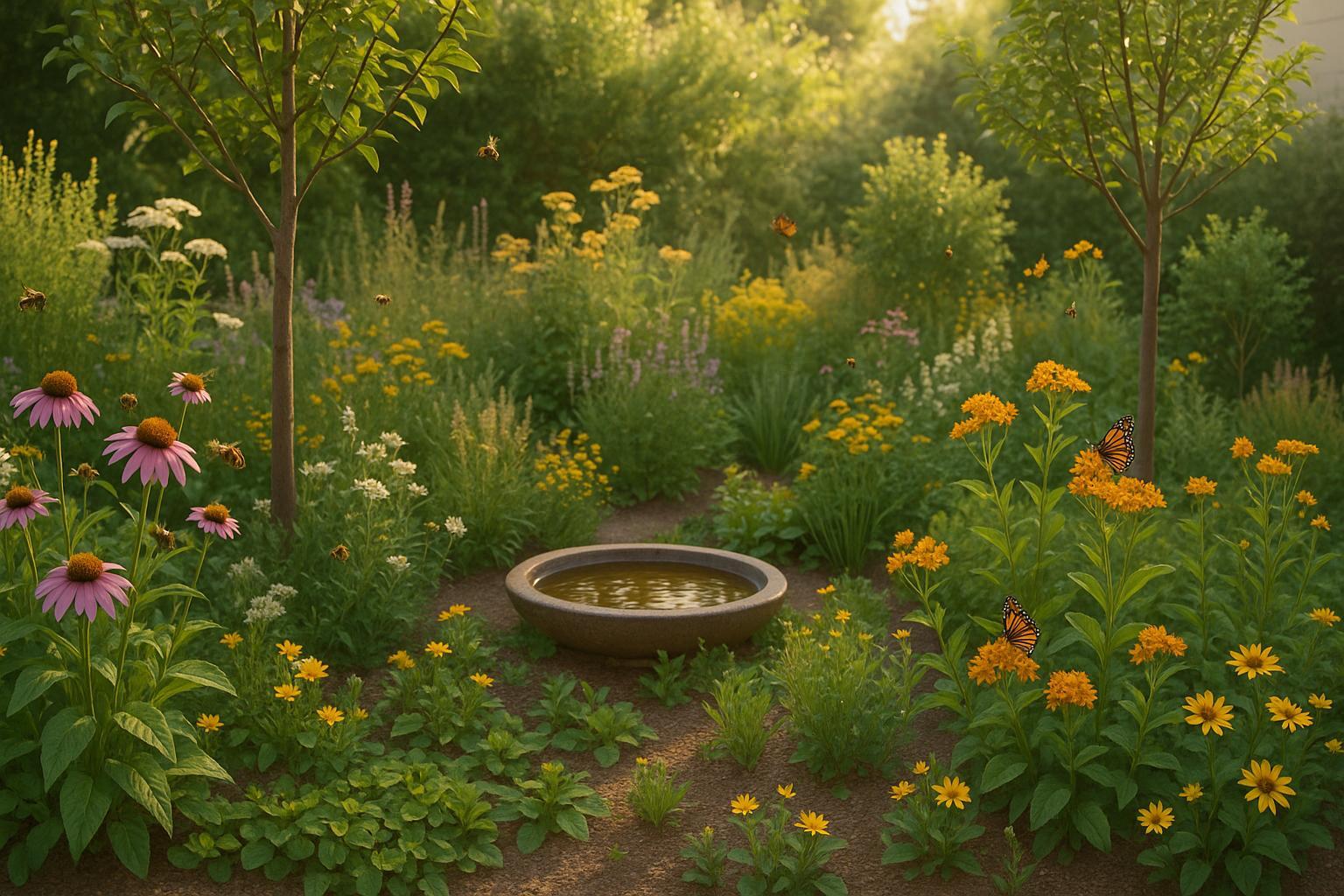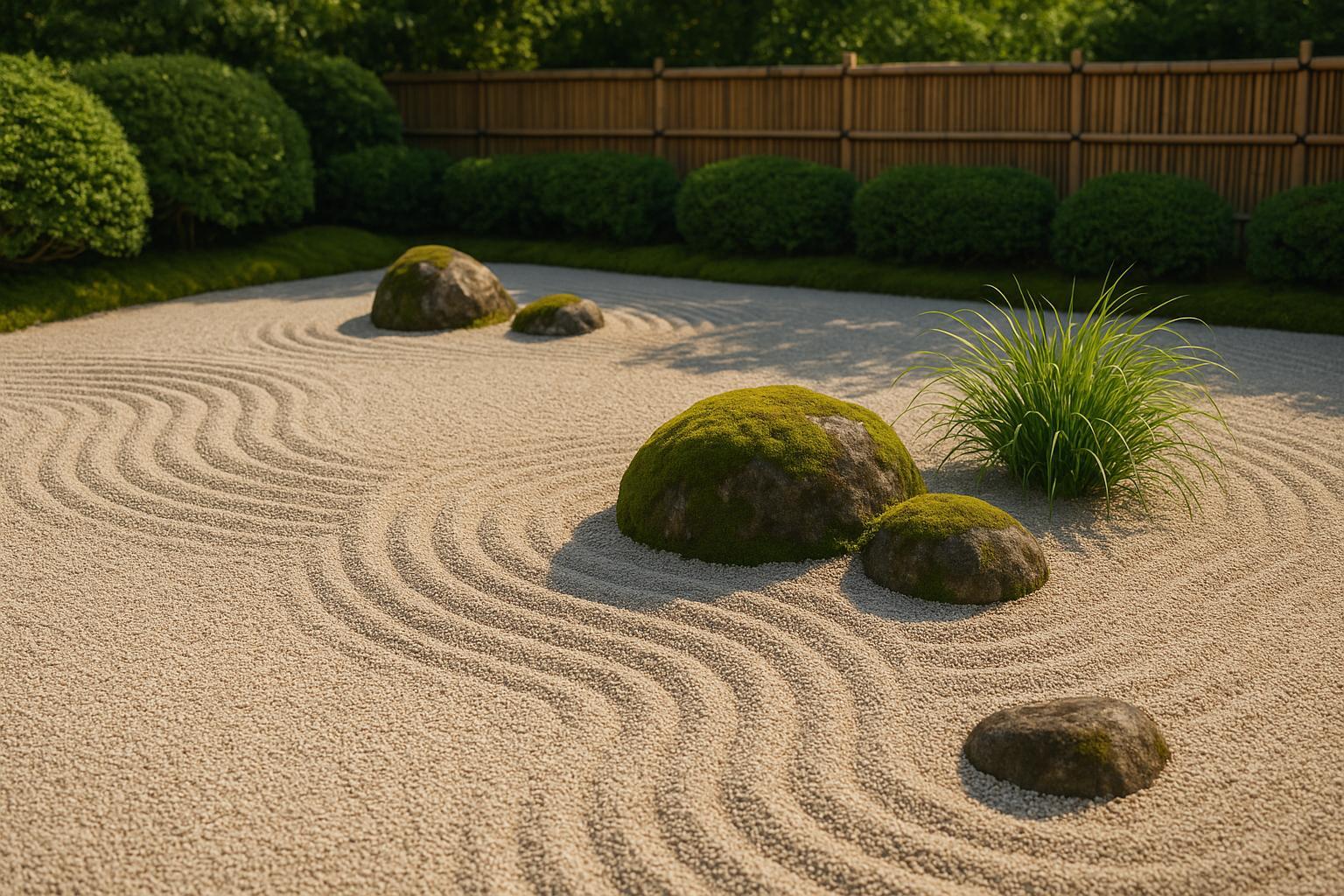Natural Stone Pavers: Benefits for Garden Paths

Natural stone pavers are a durable and stylish solution for creating garden paths that last. Unlike gravel, dirt, or concrete paths, they resist weather damage, offer better traction, and require minimal maintenance. Here’s why they’re a smart choice:
- Weather-Resistant: Withstand freeze-thaw cycles, intense sun, and heavy rain.
- Excellent Drainage: Gaps between pavers prevent water pooling and mud.
- Slip-Resistant: Textured surfaces provide grip, even when wet.
- Long-Lasting: Built to endure decades of use with proper installation.
- Low Maintenance: Easy to clean and repair, saving time and effort.
Natural stone pavers also enhance the look of your garden with a variety of colors, textures, and patterns. From sandstone to granite, there’s an option to fit any design style. Plus, they’re eco-friendly and add long-term value to your property.
For the best results, proper installation is key - prepare the base, ensure drainage, and use edge restraints to keep pavers secure. Tools like AIGardenPlanner can help you visualize designs and choose the right materials for your space. Whether you want a simple walkway or a decorative path, stone pavers combine practicality and beauty.
How to Install Tuscan Path Natural Stone Pavers on a Concrete Base


Natural Stone Pavers: Solutions to Path Problems
Natural stone pavers offer durable, low-maintenance options to tackle common garden path challenges. Here's how they address key issues:
Long-Term Strength and Durability
When installed properly, natural stone pavers can handle years of wear and tear. Their dense composition holds up against heavy foot traffic, outdoor furniture, and even impacts from falling branches or tools. They also resist damage from temperature swings and prolonged sun exposure, keeping your paths both functional and attractive over time.
Easy Maintenance and Repairs
Thanks to their modular design, maintaining natural stone pavers is straightforward. If one gets damaged, you can replace it individually without disrupting the entire path. Regular cleaning and simple upkeep of the joints help retain both the appearance and functionality of the path, saving effort and money in the long run.
Safety and Water Drainage
Natural stone pavers are designed with safety and water management in mind. Their porous surfaces allow for effective drainage, reducing puddles and preventing ice buildup during colder months. The textured finish enhances traction on wet surfaces, while proper edge restraints keep the pavers secure, ensuring a stable and weather-resistant path.
Main Advantages of Stone Pavers
Design Options and Styles
Natural stone pavers bring a wide range of choices to garden design with their variety of colors, textures, and patterns. From the warm tones of sandstone to the cooler shades of slate, their natural variations can enhance the look of any outdoor space. These stones can add a distinct charm to pathways and other garden features.
With tools like AIGardenPlanner's visual design software, planning your garden becomes much easier. Whether you're envisioning a peaceful Japanese Zen garden, a lively Mediterranean-style patio, or a sleek modern landscape, there's a stone paver option to match your vision.
Benefits of Using Natural Materials
Stone pavers are often chosen for their environmentally friendly qualities. Since they are quarried directly from the earth and require little processing, they tend to have a smaller environmental footprint compared to heavily manufactured materials. This makes them a great option for homeowners looking to make eco-conscious choices. On top of that, they offer long-lasting appeal and can significantly enhance the look of your property.
Long-Term Value
Stone pavers not only improve the look of your outdoor spaces but also add long-term value to your property. They’re built to last, offering durability and reducing the need for frequent replacements or repairs.
| Aspect | Benefit |
|---|---|
| Property Value | Boosts curb appeal and resale potential |
| Durability | Stands up to harsh weather for many years |
sbb-itb-4d6a8dd
🚀 Ready to Reinvent Your Garden?
Join thousands of homeowners who have transformed their gardens using our AI design tool. Upload one photo to explore endless possibilities.
Get your AI garden designs →How to Select and Install Stone Pavers
Stone Types and Uses
Choosing the right pavers depends on your area's climate and how much foot or vehicle traffic the surface will handle. For heavy-use areas like driveways, go with durable options like granite or bluestone. If you're designing a quiet garden path or a decorative walkway, softer stones like limestone or sandstone can add charm without needing to withstand heavy wear.
| Stone Type | Best Uses | Durability Rating |
|---|---|---|
| Granite | Driveways, high-traffic paths | Excellent |
| Bluestone | Patios, garden paths | Very Good |
| Limestone | Decorative walkways | Good |
| Sandstone | Stepping stones, garden borders | Moderate |
Installation Methods
To install stone pavers properly, follow these steps:
- Excavation: Dig 6–8 inches down to create space for the base layers.
- Base Preparation: Add 4 inches of compacted gravel for stability, followed by a 1-inch layer of leveling sand.
- Spacing: Leave a 1/2-inch gap between pavers to allow for drainage and minimize cracking.
Key tips for a successful installation:
- Slope: Ensure a 1-inch drop per 8 feet to direct water runoff.
- Edging: Use plastic or metal edge restraints to keep the pavers in place.
- Joints: Fill the gaps with polymeric sand. This helps lock the pavers in place and prevents weeds from growing.
Once the base is ready, refine your design using digital tools.
Design with AIGardenPlanner

AIGardenPlanner can turn your garden photos into detailed paver layouts. This platform even includes an AI Plant Advisor to suggest plants that match your local climate and your preferred level of maintenance.
AIGardenPlanner offers tools to streamline your project, including:
- Detailed paver and plant visualizations to see how everything will look.
- Climate-specific suggestions to ensure your design thrives.
- Accurate measurements for easier installation.
- Over 50 garden styles to inspire your creativity.
Conclusion: Designing Garden Paths That Last
Natural stone pavers provide a durable and visually appealing option for garden paths, combining practicality with style. Their strength and low maintenance make them a smart choice for homeowners looking to refresh their outdoor spaces without constant upkeep.
Tools like AIGardenPlanner simplify the design process by transforming your photos into polished layouts with ease. With precise planning and visualization, these AI-powered tools let you experiment with various paver layouts and plant pairings before committing to construction.
By pairing sturdy materials with advanced design tools, you can create garden paths that balance functionality and elegance. Whether it’s a straightforward walkway or a more intricate outdoor area, natural stone pavers offer a long-lasting and eco-conscious solution that requires little maintenance.
For a cohesive look, AIGardenPlanner's AI Plant Advisor helps align your path design with nearby plants, while its growing guides and care schedules ensure smooth integration of hardscaping and greenery.
FAQs
What should I consider when selecting natural stone pavers for my garden path, especially regarding climate and foot traffic?
When choosing natural stone pavers for your garden path, it’s important to consider both your local climate and the amount of foot traffic the path will endure. For colder climates, opt for stones that can withstand freeze-thaw cycles without cracking, such as granite or slate. In areas with heavy rainfall, look for stones with good drainage properties and a naturally non-slip surface to ensure safety.
For high-traffic paths, select durable stones like bluestone or flagstone, which resist wear and tear over time. If your path is more decorative and sees lighter use, softer stones like limestone may be a good fit. By carefully matching the stone type to your environment and usage, you’ll create a path that’s both beautiful and long-lasting.
What are the essential steps to install natural stone pavers for a durable and stable garden path?
To ensure your natural stone pavers are installed properly and last for years, follow these key steps:
- Prepare the area: Clear the path of any vegetation, debris, or obstacles. Excavate the area to a depth of about 6–8 inches, depending on the expected load and soil type.
- Lay a solid foundation: Add a layer of crushed stone or gravel (around 4–6 inches thick) for drainage and stability. Compact it thoroughly with a tamper or plate compactor.
- Add a sand layer: Spread a 1–2 inch layer of coarse sand over the base. Level it out evenly to create a smooth surface for the pavers.
- Place the pavers: Arrange the natural stone pavers in your desired pattern, leaving small gaps between them for joint material. Use a rubber mallet to gently tap them into place.
- Fill the joints: Sweep fine sand or polymeric sand into the gaps between the pavers. This helps lock them in place and prevents movement over time.
- Compact and finish: Use the compactor again to ensure the pavers are firmly set. Add more sand if needed to fill any remaining gaps.
Taking these steps will help create a durable, stable, and visually appealing garden path. For personalized garden design ideas and inspiration, consider exploring tools like AIGardenPlanner to bring your vision to life!
What are the environmental benefits of using natural stone pavers for garden paths compared to materials like concrete or asphalt?
Natural stone pavers are often considered a more environmentally friendly choice for garden paths compared to concrete or asphalt. They are made from natural materials, which means they require less energy-intensive processing and produce fewer emissions during manufacturing. Additionally, stone is a durable, long-lasting material that reduces the need for frequent replacements, minimizing waste over time.
Another benefit is their permeability. Unlike concrete or asphalt, many natural stone pavers allow water to seep through, reducing runoff and helping to replenish groundwater. This makes them an excellent choice for eco-conscious gardeners looking to create sustainable outdoor spaces.
Related posts
Related Articles

AI Tools for Soil Health Monitoring
AI tools revolutionize soil health monitoring, offering real-time data and insights to enhance gardening and farming practices.

Checklist for AI-Driven Biodiversity Planning
Learn how AI tools can simplify biodiversity planning in your garden, helping you choose plants, design layouts, and maintain a thriving ecosystem.

The Ultimate Guide to 4 x 8 Raised Bed Gardening: Building, Planting, and Maintenance
Discover the benefits of 4 x 8 raised bed gardening and learn how to build, plant, and maintain your own garden. This guide covers everything from selecting materials to choosing the best plants for your raised bed.

AI vs. Traditional Methods for Garden Restoration
Explore the advantages and challenges of AI-powered tools versus traditional methods in garden restoration to find the best approach for your project.

Ultimate Guide to Weed Control in Zen Gardens
Learn effective strategies for keeping your Zen garden weed-free through natural methods, thoughtful design, and consistent maintenance.

Ultimate Guide to Winter Wildlife Gardening
Transform your garden into a wildlife sanctuary this winter by providing essential food, water, and shelter for birds and small mammals.